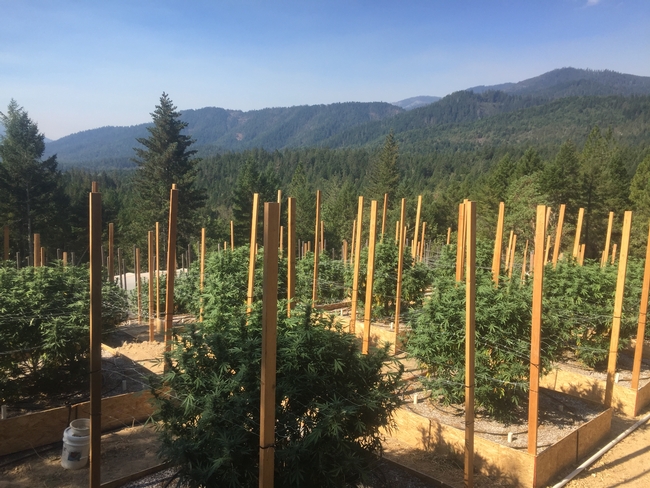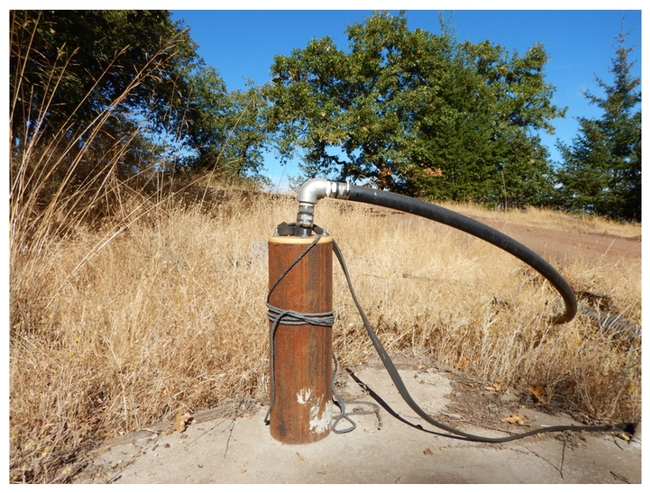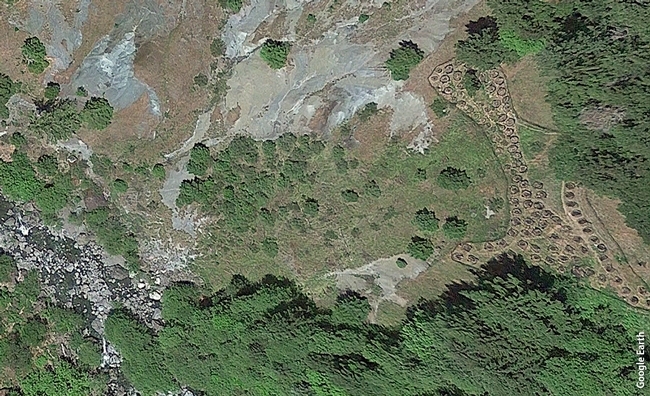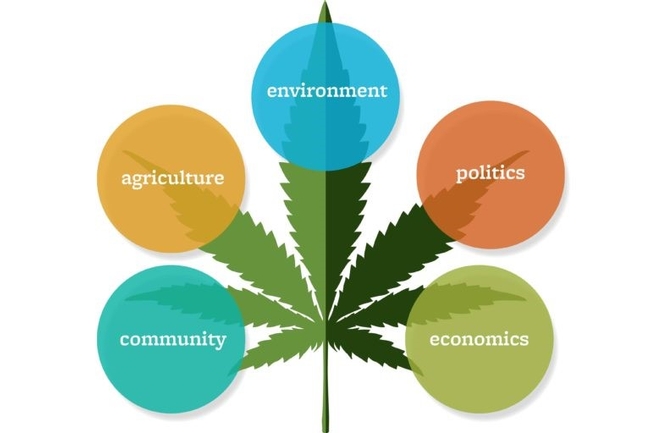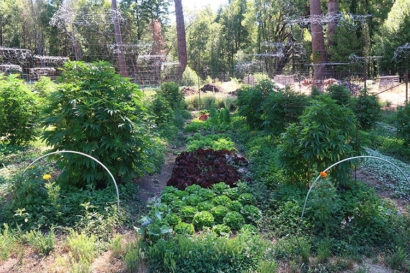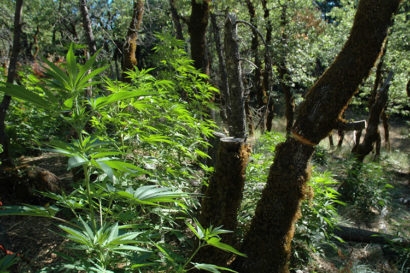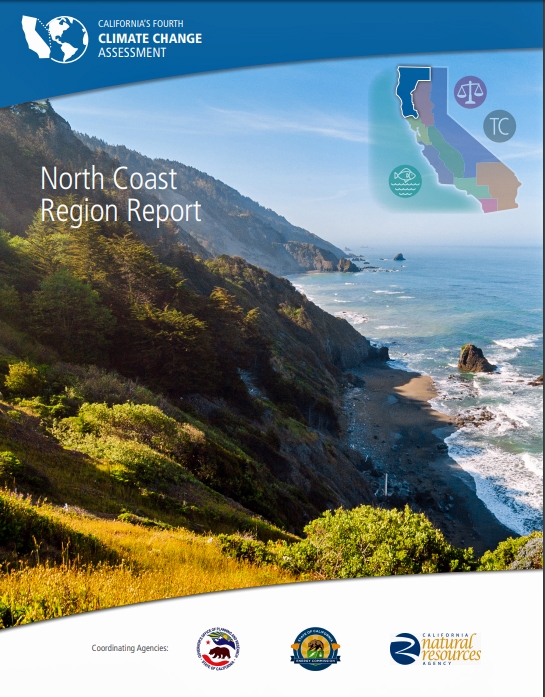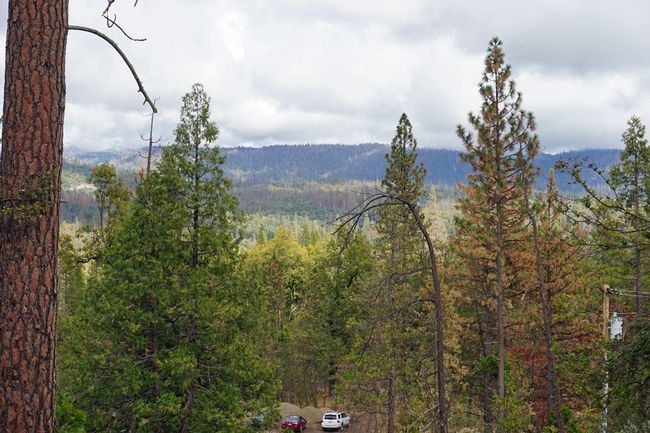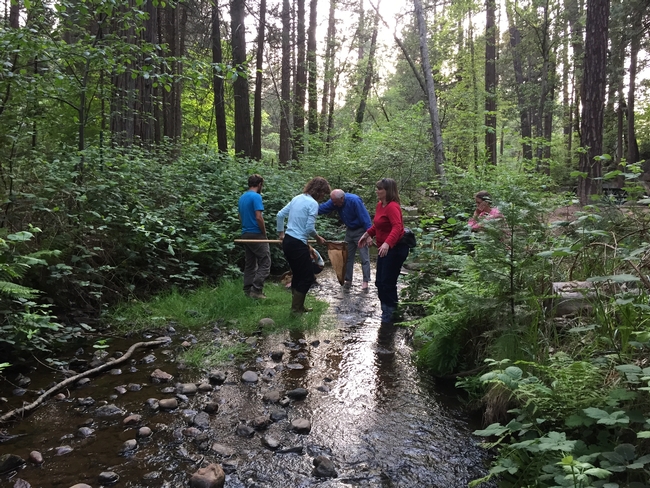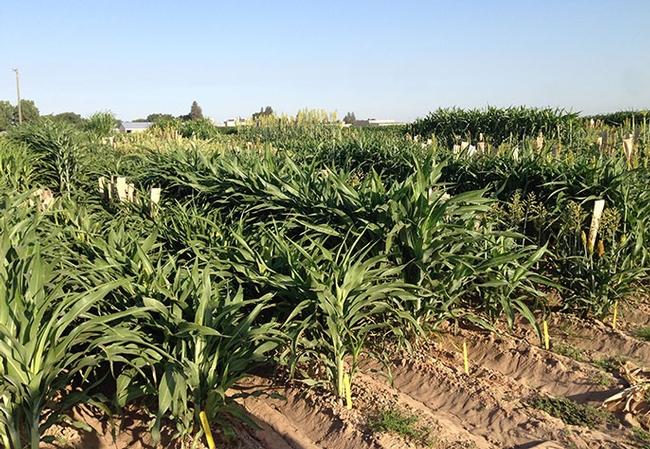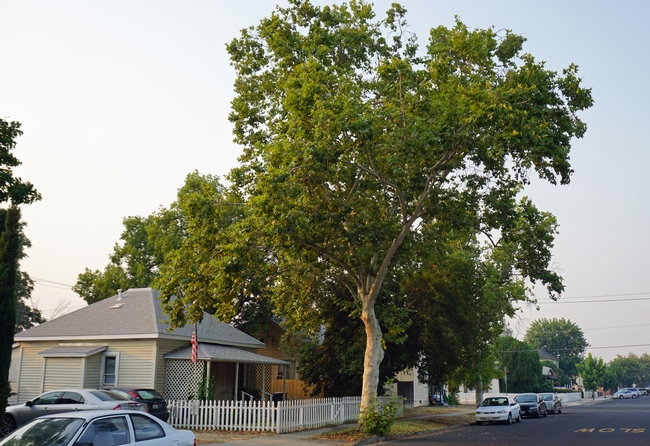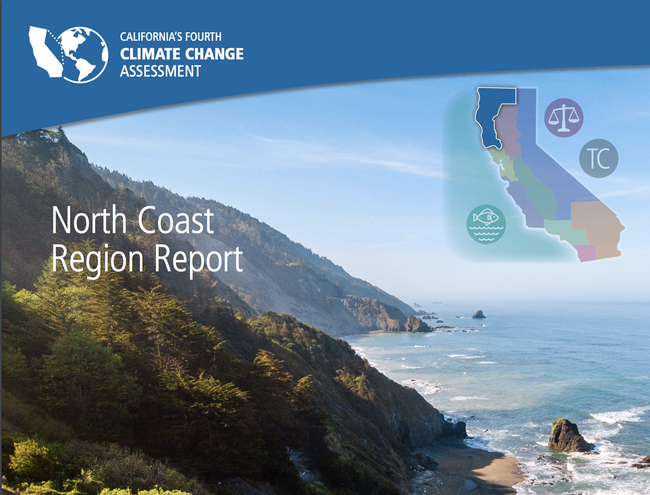Posts Tagged: Ted Grantham
Cannabis farms irrigating with groundwater may affect stream flows
The legalization of marijuana for recreational use in California has encouraged growers to expand plantings of the lucrative crop. Like any plant, cannabis requires water to grow. A new study from the Cannabis Research Center at UC Berkeley examined where cannabis growers in California are getting water for their crops, highlighting significant gaps in cannabis cultivation policy.
Environmental advocates have expressed concern that cannabis farms are diverting water from rivers and streams, which could harm fish and other wildlife.
The researchers studied water use in 11 of the state's top cannabis-producing counties – Humboldt, Lake, Mendocino, Monterey, Nevada, San Luis Obispo, Santa Barbara, Santa Cruz, Sonoma, Trinity, and Yolo.
Using California state cannabis permitting data, the researchers found that cannabis farms rely primarily on groundwater wells, not streams, for their irrigation needs. But pumping groundwater could also have an undesirable effect on wildlife.
“Wells drilled near streams in upland watersheds have the potential to cause rapid streamflow depletion similar to direct surface water diversions,” said co-author Ted Grantham, UC Cooperative Extension specialist and co-director of the Cannabis Research Center.
The Sustainable Groundwater Management Act, or SGMA, enacted in 2014, is designed to prevent overdraft of groundwater and protect water quality and supplies for agriculture, residents, fish and other wildlife.
But according to Grantham, “Most of the cannabis farms fall outside of the groundwater basins regulated under SGMA, so well use represents an important, but largely unregulated threat to streams in the region."
The researchers found that well use by cannabis farms is common statewide, exceeding 75% among farms that have permits to grow in nine of the 11 top cannabis-producing counties. In eight of the 11 counties, more than one-quarter of farms using wells are located outside of groundwater basins subject to state groundwater use regulations. Farms growing larger acreages of cannabis pumped more groundwater for irrigation, while farms with on-farm streams or located in areas that receive more rainfall were less reliant on wells.
The study relied on water-source data only for cannabis farms that have state permits to grow.
Based on models, the researchers estimate the majority (60%) of unregulated Northern California cannabis farms in Humboldt and Mendocino counties are likely to use groundwater wells if they follow the same patterns as the regulated industry.
“Our results suggest that proactive steps be taken to address groundwater use in cannabis regulations in California and call for further research into the effects of groundwater use on streamflow, especially outside of large groundwater basins,” write the authors.
The paper, “Cannabis farms in California rely on wells outside of regulated groundwater basins,” by Christopher Dillis, Van Butsic, Jennifer Carah, Samuel C. Zipper and Grantham is published in Environmental Research Communications at https://doi.org/10.1088/2515-7620/ac1124.
UC ANR scientists receive state cannabis research grants
Several scientists affiliated with the University of California Agriculture and Natural Resources have received grants from the California Bureau of Cannabis Control. The BCC awarded on Nov. 13 a total of $29,950,494 in public university research grants across California for research projects related to the implementation and effect of Proposition 64.
Research proposals had to fall within one of the several specified categories, including public health, criminal justice and public safety, economics, environmental impacts and the cannabis industry.
UC ANR-related cannabis projects and their principal investigators include:
Cannabis industry: Assessment of the location, structure, function, and demographics of licensed cannabis, focusing on geographical price differences, and differential impacts of local Prop 64-related regulations on the competitiveness of licensed businesses – Daniel Sumner, UC Davis professor in the Department of Agricultural and Resource Economics and director of the UC Agricultural Issues Center, $726,816
Economic impacts: Market prices for licensed and unlicensed cannabis and the effects of the current and alternate cannabis tax structures and tax rates on the private and public sectors in California, including government administrative costs and revenues - Sumner, $655,564
Environmental impacts of cannabis cultivation in California as affected by the farm economics of licensed and unlicensed cannabis production, including effects of testing regulations and compliance with the criminal prohibition of unlicensed cannabis - Sumner, $562,240
Assessing environmental impacts of cannabis-related noise and light disturbance to inform management of California wildlife – Justin Brashares, UC Berkeley professor in the Department of Environmental Science, Policy and Management, and Phoebe Parker Shames, graduate student, $489,762
Examining tribal sovereignty over cannabis permitting on native ancestral lands – Jennifer Sowerwine, UC Cooperative Extension specialist; Peter Nelson, professor; and Van Butsic, UC Cooperative Extension specialist; all in the UC Berkeley Department of Environmental Science, Policy and Management, $465,902
Cultivation bans, local control, and the effects and efficacy of Proposition 64 – Christy Getz, UC Cooperative Extension specialist in the UC Berkeley Department of Environmental Science, $328,916
Cannabis and wildfire: Current conditions, future threats, and solutions for farmers – Ted Grantham, UC Cooperative Extension specialist in the UC Berkeley Department of Environmental Science and Butsic, $319,091
Cannabis water-use impacts to streamflow and temperature in salmon-bearing streams – Mary Power, professor in the UC Berkeley Department of Integrative Biology, and Grantham, $314,417
The effect of local cannabis regulation on property prices – Butsic, $270,269
California cannabis workers: perceptions, beliefs, and knowledge of occupational health and industry hazards – Marc Schenker, professor in the UC Davis School of Medicine's Department of Public Health Sciences, $144,949
Related stories:
Cannabis Research Center at UC Berkeley https://rausser.berkeley.edu/news/2020/11/researchers-receive-grants-bureau-cannabis-control.
Cannabis and Hemp Research Center at UC Davis https://cannabis.ucdavis.edu/news/BCCawards
For a list of all public university projects funded by the Bureau of Cannabis Control, visit https://bcc.ca.gov/about_us/documents/media_20201113.pdf.
New Cannabis Research Center to explore environmental, social impacts of legalization
Cannabis is unlike any other agricultural crop. Because of its circuitous history — once illegal to grow, and now legal but heavily regulated — cannabis has cast a unique footprint on the environment and the communities of farmers who grow it.
UC Berkeley's new Cannabis Research Center, announced today by a multidisciplinary team of faculty, will explore how cannabis production impacts the environment and society, and how these impacts will evolve under new regulations set in place by legalization.
While other research groups in the University of California are focusing on the individual and public health ramifications of cannabis, the center will be the first in the UC system to explore oft-overlooked dimensions of cannabis growth.
Berkeley News spoke with center co-directors Van Butsic and Ted Grantham, both assistant cooperative extension specialists in UC Berkeley's Department of Environmental Science, Policy and Management, to learn more about the state of cannabis production in California and the center's goals.
Berkeley News: What are some of the ecological and community impacts of cannabis production?
Ted Grantham: My research primarily focuses on the impacts of water use. These farms are taking water directly from streams or from groundwater wells connected to streams. Most farms are located in smaller watersheds, so even though the total amount of water taken can be small, it can have a big impact on streams that support sensitive species, such as salmon. Other potential ecological impacts relate to the use of pesticides and fertilizers, and habitat fragmentation from building roads and clearing trees.
The social scientists in the center are also concerned about equity and the sustainability of growing communities. Historically many growers would be characterized as small-scale, and there is concern that through this process of legalization, there is going to be a consolidation of cannabis production following models of industrial agriculture. We are trying to understand if there is a way to have cannabis cultivation continue to sustain local economies and rural communities, while limiting impacts to the environment.
How have legalization and associated regulations affected cannabis production so far?
Van Butsic: We're about a year into the formal legalization of recreational cannabis production and it has been a rocky start. There have been fewer participants in the market — producers — than were anticipated. Some growers appear to have gone out of production, many appear to remain in black market production and a relatively small subset of growers have gone through the process of compliance. And the grower community that has pursued legal production are very vocal about the issues and challenges facing their group. We have been trying to better understand what are the barriers to compliance and, ultimately, if there can be changes made in policies that can really help to catalyze this transition.
Cannabis production makes up only a very small percentage of agriculture in California. Why is it important to study its impacts in particular?
Van Butsic: This is a great system to study really big sustainability problems. How do we develop an agricultural system that's good for the environment and good for farmers? And cannabis is a really interesting spot to look at it because the regulations enforcing cannabis are totally different than in the rest of agriculture, so it would be really interesting to see if we get different outcomes.
How do regulations differ between cannabis production and the rest of agriculture?
Van Butsic: Cultivators need to be permitted by the state water board, by local government and by state government to grow cannabis legally, and there are environmental regulations in all three of those levels that they need to comply with that require a higher order of environmental performance than most other agricultural crops.
So you think that understanding these regulations might help you apply them to other types of agriculture?
Van Butsic: Exactly. Agriculture has been notoriously difficult to regulate in the past, and this is a system where the regulators got the upper hand, and so it will be interesting to see how the producers respond, and if cannabis producers can be profitable and meet these super-high environmental performance measures, then perhaps there is knowledge and technology that can transfer from the cannabis industry to the rest of agriculture that can improve environmental performance of food production.
We are working on a big project right now where we are mapping where all the farms are after the latest regulatory changes. We want to know, if we could take down these barriers and everybody became compliant, what would that mean for local water budgets, environmental health and for the amount of cannabis that would be produced?
Ted Grantham: This is a rapidly changing industry, and no one really knows where it is headed. Everyone is playing catch up to a certain extent, and we believe researchers have an important role in bringing independent scientific information to conversations around cannabis policy.
UC Cooperative Extension works in local communities to help Californians adapt to climate change
Californians received bleak news last month when the state released its fourth assessment of climate change in California. The report predicts severe wildfires, more frequent and longer droughts, rising sea levels, increased flooding, coastal erosion and extreme heat.
“It's great to be living in a state where science and facts around climate change are valued,” said UC Cooperative Extension specialist Adina Merenlender, “but the recent forecasts may make you want to devour a quart of ice cream in a pool of salty tears.”
Modern civilization has changed the world climate, and even dramatic reductions in global greenhouse gas emissions at this point won't turn back the clock. The warming now predicted by Cal-Adapt is likely already “baked in,” even with our best mitigation efforts, said Igor Lacan, UC Cooperative Extension advisor in the Bay Area of California.
California has been a leader in facing the future climate head on. The state's first comprehensive assessment on climate change was produced in 2006 under then-Gov. Arnold Schwarzenegger. The second assessment, released in 2009, concluded that adaptation could reduce economic impacts of loss and damage from a changing climate. The third assessment was shaped by a request for more information on the adaptation options in the 2009 report. The fourth assessment was the first effort to break down global climate predictions and their impacts onto specific regions of California.
Author of the North Coast Region Report of the Fourth Assessment, Ted Grantham, praised state leaders for pushing forward efforts to slow climate change and adapt to the new weather conditions expected in California.
“California is playing a unique role in filling the void of leadership on this issue that the federal government was beginning to address under the Obama administration,” Grantham, a UC Cooperative Extension specialist based at UC Berkeley, said.
Across California, UC Cooperative Extension specialists and advisors are working in their local communities to prepare for warming temperatures and adapt to the changing climate. Following are examples of the efforts now underway.
Managing forests to survive the future
Among the suggested adaptation strategies in the 81-page North Coast Region Report, written by Grantham and his colleagues, the authors encourage government agencies and private forest owners to use prescribed fires and active forest management to reduce an overgrowth of trees and shrubs that fuel the more frequent and intense fires expected in the future.
Although climate change will create conditions conducive to catastrophic wildfire, the reason for dangerous forest overgrowth is related to decades of fire suppression on the landscape.
“Our forests are much denser and have more fuel buildup than they would have under a natural fire regime,” Grantham said. “Mechanical thinning, removing wood from the landscape and prescribed fires can help limit the impacts of wildfire.”
Native American tribes are being tapped to share their traditional ecological knowledge to inform this practice.
“Native Americans have used fire since time immemorial to manage their landscapes,” Grantham said.
Connecting habitats to allow species movement
When climate changes, plant and animal species may find their current habitats no longer fit the environment where they evolved. The fourth assessment technical report, Climate-wise Landscape Connectivity: Why, How and What Next, written by UCCE specialist Adina Merenlender, documented potential techniques to erase barriers to plant and animal movement.
“When we talk about wildlife corridors today, we might view a road as a barrier,” Merenlender said. “With climate change, the movement is over a much longer range for species to find suitable habitat at the end of the century.”
The report says research is needed to compare different approaches to designing climate-wise connectivity, determining how wide corridors need to be, and quantifying the impact of natural and anthropogenic barriers on possible range shifts.
California's wine industry is based on international varieties that come from Northern France, where the climate is cool, mild and consistent.
“They really require a cool to warm climate, not a hot climate,” said Glenn McGourty, UCCE viticulture advisor in Mendocino County.
There are many wine grape cultivars from Southern Europe – areas in Italy, Portugal and Spain – that are adapted to heat and make quality wines, but aren't well known. The varieties include Monepulciano, Sagrantino, Periquita and Graciano.
McGourty is studying how these cultivars perform in the warm interior of Mendocino County at the UC Hopland Research and Extension Center.
“We have many options as climates warm in the interior part of California to make wine that needs less amelioration in the winery compared to cultivars from Northern France,” McGourty said.
Recruiting and training climate stewards
The UC California Naturalist Program is moving full steam ahead with a new Climate Stewards Initiative to build engaged communities and functioning ecosystems that are resilient to changing climates.
California Naturalist, with trained volunteers across the state working with myriad conservation organizations, will be using its educational network to improve the public's understanding of climate change and engage the public in community action and local conservation.
“Climate stewards will offer in-person communication with your neighbors, tapping into science,” Merenlender said. “Improving climate literacy is an important outcome, but that won't happen through a website.”
Helping growers modify farming practices due to changing climate
USDA Climate Hub has awarded a grant to UC Cooperative Extension to support tools to assist growers in making strategic decisions in season and long term.
“We have many credible sources of weather and climate data, but often times we are challenged with translating it into decision support tools tailored to growers' needs,” said Tapan Pathak, UCCE specialist in climate change adaptation in agriculture. “It's too early to say which specific tools we will develop, but we are aiming to help farmers use weather and climate information in decision making processes.”
Pathak is also working with colleagues to analyze how generations of navel orangeworm, a significant almond pest, might shift for the entire Central Valley under climate change and how growers can adapt their practices to manage the higher pest pressure.
Using epigenetics to impart drought tolerance
At the UC Kearney Agricultural Research and Extension Center in Parlier and the UC West Side Research and Extension Center in Five Points, sorghum nurseries are being grown under drought and well-watered conditions to compare the environmental impacts on the plants' gene expression.
“We hope to tease out the genetics of drought tolerance in sorghum,” said Jeff Dahlberg, UCCE specialist, who is managing the trials at Kearney. “Using sorghum as a model, we expect this research to help us understand drought tolerance in other crops as well.”
Historically, the genetic manipulation of crops, which has been critical to increasing agricultural productivity, has concentrated on altering the plant's genetic sequence, encoded in its DNA.
Recent studies have shown that environmental stresses – such as drought – can lead to epigenetic changes in a plant's genetic information. Because epigenetic changes occur without altering the underlying DNA sequence, they allow plants to respond to a changing environment more quickly.
Cities can plant street tree species suited to future climate
Many common street trees now growing in the interior of California are unlikely to persist in the warmer climate expected in 2099, according to research published in the July 2018 issue of the journal Urban Forestry & Urban Greening. (Read the research report here until Sept. 27, 2018)
“Urban foresters in inland cities of California should begin reconsidering their palettes of common street trees to prepare for warmer conditions expected in 2099 due to climate change,” said the study's co-author, Igor Lacan, UC Cooperative Extension environmental horticulture advisor in the Bay Area.
Common trees in Coastal California cities appear to be better suited to withstand the 2099 climate.
“Our research shows that some trees now lining the streets of cities like Fresno, Stockton and Ukiah are likely to perform poorly in 2099,” Lacan said. “Those cities need to look at the conditions – and trees – now found in El Centro, Barstow and Fresno respectively.”
Trees to shade California in a warmer future
The changing climate predicted for California – including less rain and higher day and nighttime temperatures – is expected to cause chronic stress on many street tree species that have shaded and beautified urban areas for decades.
Realizing that popular trees may not thrive under the changing conditions, UC Cooperative Extension scientists are partnering with the U.S. Forest Service in a 20-year research study to expand the palette of drought-adapted, climate-ready trees for several of the state's climate zones.
“The idea is to look at available but under-planted, drought-tolerant, structurally sound, pest resistant trees for Southern California that do well in even warmer climates,” said Janet Hartin, UCCE horticulture advisor in San Bernardino County.
Twelve tree species were selected for each climate zone in the comparative study, with several area parks used as control sites.
Managing the forest for survival in warmer conditions
UC Cooperative Extension scientists are part of a collaborative research project with the University of Nevada, Reno, CAL FIRE and the U.S. Forest Service aimed at developing new strategies to adapt future forests to a range of possible climate change scenarios in the Sierra Nevada.
“It includes the idea that we may be struggling just to keep forests as forests, let alone having the species we value,” said Rob York, manager of UC Berkeley's Blodgett Forest Research Station near Georgetown.
Forests sequester a tremendous amount of carbon. As the climate changes, foresters will need to be proactive to reduce the risk of these massive carbon sinks becoming carbon sources.
“We're working to mitigate predicted impacts to forests, including regeneration failures, drought mortality and catastrophic wildfire,” Ricky Satomi, UCCE natural resources advisor in Shasta County.
At three separate study sites across the Sierra Nevada, novel approaches to forest management are being implemented to develop treatments that scientists believe will increase resilience, resistance and adaptability of Sierra Nevada mixed conifer forests.
The 2018-21 project is led by Sarah Bisbing, forest ecology professor at the University of Nevada, Reno, and funded with $2.7 million from CAL FIRE.
Climate change impacts on vulnerable communities
The latest climate assessment also reports on the serious nature of climate threats to vulnerable communities and tribal communities in California, with a focus on working collaboratively with these communities on research and solutions for resilience.
“The impacts of climate change will not be experienced equally among the population,” Grantham said. “The most significant public health and economic impacts – from flooding, extreme heat, air quality degradation, etc. – will be disproportionately experienced by vulnerable populations, including people of color, the poor and the elderly.”
The assessment includes a Climate Justice Report, which shares the idea that no group of people should disproportionately bear the burden of climate impacts or the costs of mitigation and adaptation. The report suggests collaborating with these communities on research and solutions for resilience.
UC ANR scientists contribute to California’s Fourth Climate Change Assessment
The California Natural Resources Agency released California's Fourth Climate Change Assessment today (Monday, Aug. 27), at http://www.ClimateAssessment.ca.gov. UC Agriculture and Natural Resources scientists contributed substantially to the report.
The Fourth Assessment is broken down into nine technical reports on the following topics:
- Agriculture
- Biodiversity and habitat
- Energy
- Forests and wildlife
- Governance
- Ocean and coast
- Projects, datasets and tools
- Public health
- Water
The technical reports were distilled into nine regional reports and three community reports that support climate action by providing an overview of climate-related risks and adaptation strategies tailored to specific regions and themes.
The regional reports cover:
- North Coast Region
- Sacramento Valley Region
- San Francisco Bay Area Region
- Sierra Nevada Region
- San Joaquin Valley Region
- Central Coast Region
- Los Angeles Region
- Inland South Region
- San Diego Region
The community reports focus on:
- The ocean and coast
- Tribal communities
- Climate justice
All research contributing to the Fourth Assessment was peer-reviewed.
UC Cooperative Extension ecosystem sciences specialist Ted Grantham – who works in the Department of Environmental Science, Policy and Management at UC Berkeley – is the lead author of the 80-page North Coast Region Report. Among the public events surrounding the release of the Fourth Assessment is the California Adaptation Forum, Aug. 27-29 in Sacramento. For more information, see http://www.californiaadaptationforum.org/. Grantham is a speaker at the forum.
Other UC ANR authors of the North Coast Region Report are:
- Lenya Quinn-Davidson, UC Cooperative Extension area fire advisor for Humboldt, Siskiyou, Trinity and Mendocino counties
- Glenn McGourty, UC Cooperative Extension viticulture and plant science advisor in Mendocino and Lake counties
- Jeff Stackhouse, UC Cooperative Extension livestock and natural resources advisor for Humboldt and Del Norte counties
- Yana Valachovic, UC Cooperative Extension forest advisor for Humboldt and Del Norte counties
UC Cooperative Extension fire specialist Max Moritz contributed to sections of the main report on Forest Health and Wildfire and to the San Francisco Bay Area Report.
UC ANR lead authors of technical reports were:
- Economic and Environmental Implications of California Crop and Livestock Adaptations to Climate Change, Daniel Sumner, director of UC ANR's Agricultural Issues Center
- Climate-wise Landscape Connectivity: Why, How and What Next, Adina Merenlander, UC Cooperative Extension specialist
- Visualizing Climate-Related Risks to the Natural Gas System Using Cal-Adapt, Maggi Kelly, UC Cooperative Extension specialist


